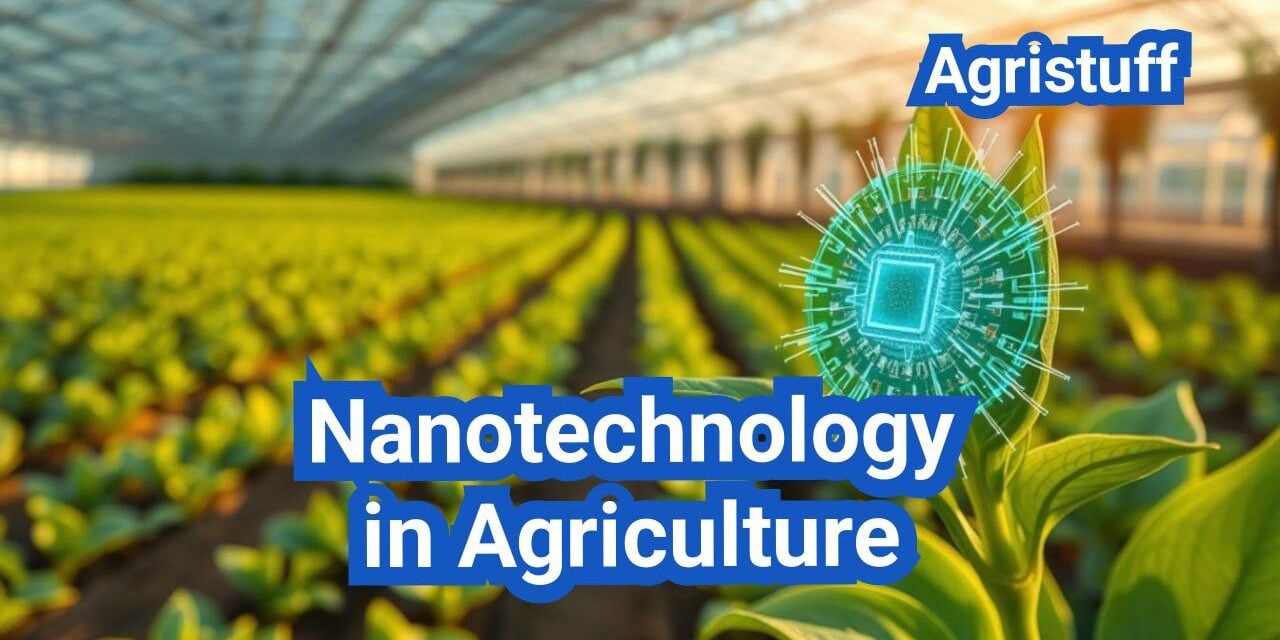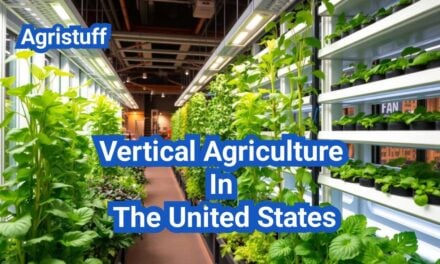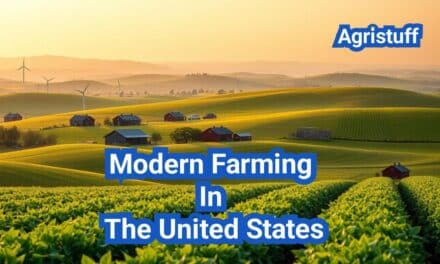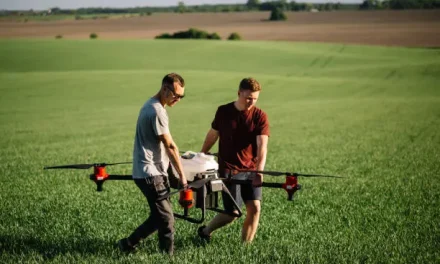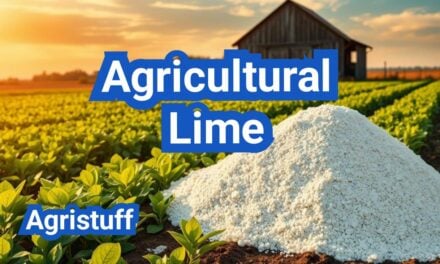The integration of nanotechnology is revolutionizing the agricultural sector by enhancing crop yields, improving resource efficiency, and promoting ecological sustainability.
Nanomaterials and nanosensors are being utilized to transform farming practices, enabling farmers to make data-driven decisions and optimize their agricultural operations.
The application of nanotechnology in agriculture is multifaceted, ranging from precision farming to smart delivery systems, and is poised to have a significant impact on the future of farming.
Key Takeaways
- Nanotechnology improves crop yields and resource efficiency.
- Nanomaterials and nanosensors enhance agricultural practices.
- Smart delivery systems optimize farming operations.
- Nanotechnology promotes ecological sustainability.
- Precision farming is a key application of nanotechnology.
Understanding Nanotechnology in Agriculture
Agricultural nanotechnology involves the manipulation of materials at the nanoscale to develop smart materials and devices that improve crop yields and reduce environmental impact. This field is rapidly evolving, offering innovative solutions to the challenges faced by modern farming.
What Is Agricultural Nanotechnology?
Agricultural nanotechnology is the application of nanotechnology in agriculture to enhance productivity and sustainability. It involves the use of nanoscale materials and devices to improve crop management, soil health, and water usage. By leveraging nanotechnology, farmers can adopt more precise and sustainable farming practices.
The use of nanoagrochemicals, for instance, allows for targeted delivery of nutrients and pesticides, reducing waste and environmental contamination. Nanosensors can monitor soil conditions, crop health, and weather patterns, enabling data-driven decision-making.
The Science Behind Manipulating Matter at Nanoscale
The science behind nanotechnology involves manipulating materials at the nanoscale (1-100 nanometers) to create materials with unique properties. At this scale, materials exhibit different physical, chemical, and biological properties compared to their bulk counterparts.
Nanosensors, for example, can be designed to detect specific chemicals or pathogens, allowing for early disease detection and prevention. Nanobionics integrates nanotechnology with biology to develop innovative solutions for crop improvement and disease management.
“The application of nanotechnology in agriculture has the potential to revolutionize the way we produce food, making it more efficient, sustainable, and environmentally friendly.”
Dr. Jane Smith, Nanotechnology Expert
Key Benefits for Modern Farming Operations
The integration of nanotechnology in agriculture offers several key benefits for modern farming operations. These include improved crop yields, reduced environmental impact, and enhanced resource efficiency.
| Benefit | Description |
|---|---|
| Increased Crop Yields | Nanoagrochemicals and nanosensors enable precise crop management, leading to higher yields. |
| Reduced Environmental Impact | Targeted delivery of nutrients and pesticides minimizes waste and environmental contamination. |
| Enhanced Resource Efficiency | Nanotechnology improves water usage and soil health, reducing the need for resources. |
By adopting nanotechnology, farmers can improve their operations’ sustainability and productivity, contributing to a more food-secure future.
How to Assess Your Farm’s Readiness for Nanotechnology

Before integrating nanotechnology into your farming operations, it’s crucial to assess your farm’s current state and readiness for such advanced techniques. This assessment will help you understand whether nanotechnology is a viable solution for your agricultural challenges.
Evaluating Current Agricultural Challenges
The first step in assessing your farm’s readiness is to evaluate your current agricultural challenges. This involves identifying issues such as soil degradation, water scarcity, pest management, and crop yield optimization. By understanding these challenges, you can determine where nanotechnology can make the most impact.
Nanotechnology applications in agriculture offer solutions to many common farming problems. For instance, nano-enabled sensors can monitor soil moisture levels, temperature, and crop health in real-time, enabling precision agriculture practices.
Identifying Potential Nanotechnology Solutions
Once you’ve identified your agricultural challenges, the next step is to explore potential nanotechnology solutions. This could include using nano-fertilizers for more efficient nutrient delivery, nano-pesticides for targeted pest control, or nanobubble technology for improved irrigation.
It’s essential to research and understand how different nanotechnology applications can address your specific farming needs. For example, plant-wearable sensors can provide real-time data on plant health, helping you optimize growing conditions and improve crop yields.
Conducting a Cost-Benefit Analysis
After identifying potential nanotechnology solutions, it’s crucial to conduct a cost-benefit analysis. This involves evaluating the costs associated with adopting nanotechnology, such as equipment purchases and training, against the potential benefits, such as increased crop yields and reduced input costs.
A thorough cost-benefit analysis will help you determine whether investing in nanotechnology is a viable decision for your farm. Consider factors such as the expected return on investment, the potential for improved farm management, and the long-term sustainability of nanotechnology applications.
By carefully assessing your farm’s readiness for nanotechnology and conducting a thorough cost-benefit analysis, you can make informed decisions about adopting these advanced technologies and potentially improve your farming operations.
Implementing Nano-Enabled Sensors for Farm Monitoring
The use of nanosensors in agriculture is enabling farmers to make data-driven decisions. Nanosensors can detect real-time changes in soil moisture, nutrient levels, and pathogen presence, providing valuable insights for farm management.
Selecting the Right Nano-Sensors for Your Crops
Choosing the appropriate nano-sensors for your agricultural needs is crucial. Consider factors such as the type of crops, soil conditions, and the specific parameters you want to monitor. For instance, nanosensors that detect soil moisture levels can help optimize irrigation schedules.
Different crops have different requirements, and the right sensors can help you tailor your farming practices. For example, sensors that monitor nutrient levels can guide fertilizer application, reducing waste and environmental impact.
Installation and Calibration Procedures
Proper installation and calibration of nano-sensors are essential for accurate data collection. Begin by following the manufacturer’s guidelines for installation, ensuring that sensors are placed in representative areas of your farm.
Calibration involves adjusting the sensors to match the specific conditions of your farm. This may involve setting threshold values for parameters like soil moisture or nutrient levels. Regular maintenance is also crucial to ensure continued accuracy.
Interpreting Sensor Data for Decision Making
The data collected by nano-sensors is only valuable if it’s properly interpreted. Use the information to identify trends and patterns in your farm’s conditions. For example, data on soil moisture levels can inform irrigation decisions, while nutrient level data can guide fertilizer application.
By integrating sensor data analysis into your farm management practices, you can make more informed decisions, enhancing the efficiency and productivity of your agricultural operations. This is a key aspect of precision agriculture, allowing for targeted interventions that improve crop yields and reduce environmental impact.
Setting Up Graphene Agricultural Sensors Step-by-Step

The use of graphene sensors in agriculture represents a significant advancement in precision farming techniques. These sensors offer high sensitivity and durability, making them ideal for monitoring various parameters in agricultural fields.
Purchasing and Preparation Guidelines
When purchasing graphene agricultural sensors, it’s essential to consider factors such as sensor sensitivity, durability, and compatibility with existing farm infrastructure. Ensure that the sensors are specifically designed for agricultural use and can withstand various environmental conditions.
Preparation involves calibrating the sensors according to the manufacturer’s instructions. This step is crucial for ensuring accurate data collection. Calibration typically involves exposing the sensors to known conditions and adjusting them accordingly.
Key Considerations for Purchasing Graphene Sensors:
- Sensitivity to target parameters (e.g., moisture, temperature)
- Durability and resistance to environmental factors
- Compatibility with farm management software
- Power supply requirements and battery life
Deployment Strategies Across Different Field Types
Deploying graphene agricultural sensors effectively requires a strategic approach tailored to the specific field conditions. For instance, in fields with varied topography, sensors should be placed to capture data from different elevations and soil types.
In irrigated fields, sensors can be positioned to monitor soil moisture levels, helping to optimize irrigation schedules. In rain-fed fields, sensors can track soil moisture and temperature, providing insights into crop water stress.
| Field Type | Sensor Placement Strategy | Parameters to Monitor |
|---|---|---|
| Irrigated Fields | Near irrigation lines and at varying depths | Soil moisture, temperature |
| Rain-fed Fields | At multiple depths to capture soil profile | Soil moisture, temperature |
| Fields with Varied Topography | At different elevations and aspects | Soil moisture, temperature, other relevant parameters |
“The integration of graphene sensors into agricultural practices is revolutionizing how we monitor and manage crop health. By providing real-time data, these sensors enable farmers to make informed decisions that can significantly improve crop yields and reduce environmental impact.” – Dr. Jane Smith, Agricultural Technologist
Maintenance and Troubleshooting Protocols
Regular maintenance is crucial for ensuring the longevity and accuracy of graphene agricultural sensors. This includes cleaning the sensors periodically, checking for physical damage, and updating software as necessary.
Troubleshooting involves identifying and resolving issues such as data discrepancies or sensor malfunctions. Common troubleshooting steps include recalibrating sensors, checking power supply connections, and consulting manufacturer support resources.
Maintenance Schedule:
- Weekly: Check sensor functionality and data transmission.
- Monthly: Clean sensors and inspect for physical damage.
- Quarterly: Update software and recalibrate sensors as needed.
How to Integrate Plant-Wearable Sensors with Farm Management
Plant-wearable sensors are transforming farm management by providing real-time data on plant health and stress levels. This integration enables farmers to make precise adjustments to growing conditions, ultimately improving crop yields and reducing waste.
Attaching Sensors to Different Plant Types
The first step in integrating plant-wearable sensors is attaching them to the plants. Different crops require different sensor attachment methods. For instance, sensors can be clipped to leaves, inserted into the soil near the roots, or even wrapped around the stem. It’s crucial to choose the right attachment method to ensure accurate data collection and minimize damage to the plants.
For delicate crops like leafy greens, a gentle clip-on mechanism may be appropriate. In contrast, for more robust plants like corn, a more secure attachment method such as wrapping the sensor around the stem might be necessary.
Setting Up Data Collection Systems
Once the sensors are attached, the next step is to set up a data collection system. This typically involves creating a network that allows the sensors to transmit data to a central hub or cloud-based platform. The choice of communication protocol (e.g., Wi-Fi, Bluetooth, or cellular) depends on the farm’s infrastructure and the range required for data transmission.
Key considerations for setting up data collection systems include:
- Ensuring reliable power supply for the sensors
- Implementing data encryption for security
- Configuring data storage solutions for long-term analysis
Using Plant Data to Optimize Growing Conditions
The real power of plant-wearable sensors lies in their ability to provide actionable insights. By analyzing the data collected, farmers can identify early signs of stress, disease, or nutrient deficiencies. This allows for targeted interventions, such as adjusting irrigation schedules, applying specific fertilizers, or implementing pest control measures.
For example, if the sensors detect a drop in soil moisture levels, the farmer can activate irrigation systems to maintain optimal moisture. Similarly, if the data indicates a rise in temperature stress, shading systems can be deployed to protect the crops.
By leveraging the data from plant-wearable sensors, farmers can create a more responsive and efficient farm management system, ultimately leading to improved crop health and increased productivity.
Implementing IoT with Nanosensors for Precision Agriculture
The integration of IoT with nanosensors is revolutionizing precision agriculture by enabling real-time monitoring and automated responses. This combination allows farmers to gather detailed data on their crops and make informed decisions to optimize yields.
Building a Farm-Wide Sensor Network
To implement IoT with nanosensors effectively, establishing a comprehensive sensor network across the farm is crucial. This involves:
- Identifying key areas for sensor placement
- Selecting appropriate nanosensors for different crop types and conditions
- Ensuring reliable connectivity and data transmission
Connecting Sensors to Central Monitoring Systems
Once the sensor network is in place, connecting these sensors to a central monitoring system is essential for data collection and analysis. This step involves:
- Configuring the sensors to transmit data to the central system
- Implementing data processing and analytics tools
- Setting up user interfaces for easy data interpretation
Benefits of a Centralized System: A centralized monitoring system allows for real-time data analysis, enabling farmers to respond quickly to changes in crop conditions.
Creating Automated Response Protocols
Automated response protocols are critical for maximizing the benefits of IoT and nanosensors in precision agriculture. These protocols involve:
- Defining threshold values for different crop parameters
- Configuring automated responses to alerts, such as irrigation or fertilization
- Continuously monitoring and adjusting the protocols based on crop performance
The table below illustrates a sample automated response protocol for different crop conditions:
| Crop Condition | Threshold Value | Automated Response |
|---|---|---|
| Soil Moisture | < 20% | Irrigation Activation |
| Temperature | > 35°C | Shading or Cooling System Activation |
| Nutrient Levels | < Optimal Range | Fertilizer Application |
By implementing IoT with nanosensors and creating automated response protocols, farmers can significantly enhance their precision agriculture practices, leading to improved crop yields and reduced operational costs.
Applying Nano-Fertilizers for Maximum Crop Efficiency

Nano-fertilizers are revolutionizing the way we approach crop nutrition, providing a more efficient and targeted delivery system. By enhancing nutrient uptake and reducing waste, nano-fertilizers offer a promising solution for modern farming challenges.
Selecting Appropriate Nano-Fertilizers by Crop Type
Different crops have varying nutrient requirements, making it essential to select the right nano-fertilizer for the specific crop type. For instance, nitrogen-based nano-fertilizers are often used for crops like corn and wheat, while phosphorus-based nano-fertilizers are more suitable for crops like soybeans and potatoes.
- Crop-specific nutrient requirements: Understanding the nutrient needs of your crops is crucial for selecting the appropriate nano-fertilizer.
- Nano-fertilizer types: Various types of nano-fertilizers are available, including those based on nitrogen, phosphorus, and potassium.
Application Methods and Equipment Requirements
The application method of nano-fertilizers can significantly impact their effectiveness. Common application methods include foliar spraying, soil application, and seed coating. Each method requires specific equipment, such as sprayers, drills, or seed treaters.
- Foliar spraying: This method involves spraying nano-fertilizers directly onto the leaves of plants.
- Soil application: Nano-fertilizers can be applied to the soil, where they are absorbed by the roots.
Monitoring Plant Response and Adjusting Treatments
After applying nano-fertilizers, it is crucial to monitor plant response and adjust treatments as necessary. This involves tracking crop health, yield, and nutrient uptake efficiency.
- Monitoring crop health: Regularly inspect crops for signs of nutrient deficiencies or excesses.
- Adjusting application rates: Based on crop response, adjust the application rate of nano-fertilizers to optimize their effectiveness.
Using Nano-Pesticides for Controlled Release Protection

Nano-pesticides are revolutionizing crop protection by offering controlled release mechanisms that enhance efficacy and reduce environmental impact. This innovative approach to pest management involves encapsulating pesticides in nanoparticles, allowing for targeted delivery and sustained release.
Transitioning from Traditional to Nano-Encapsulated Pesticides
The shift from conventional pesticides to nano-encapsulated formulations represents a significant advancement in agricultural pest control. Traditional pesticides often result in excessive chemical application, leading to environmental contamination and the development of pesticide-resistant pests. In contrast, nano-pesticides provide a more precise and efficient method of pest management.
Nano-encapsulation technology involves enclosing active pesticide ingredients within nanoparticles, which can be made from various materials, including polymers and lipids. This encapsulation enhances the stability and solubility of the pesticide, allowing for more effective delivery and reduced environmental degradation.
Application Techniques for Different Pest Challenges
The application of nano-pesticides can be tailored to address various pest challenges across different crops. Techniques include foliar spraying, soil application, and seed coating, each designed to optimize the delivery of nano-pesticides to the target site.
- Foliar spraying is effective for controlling pests on leaf surfaces.
- Soil application helps manage soil-dwelling pests.
- Seed coating provides protection from the early stages of plant growth.
Measuring Effectiveness and Environmental Impact
To assess the effectiveness of nano-pesticides, farmers can monitor pest control efficacy, crop health, and yield improvements. Environmental impact assessments involve evaluating the reduction in chemical usage, soil and water contamination, and effects on non-target organisms.
Studies have shown that nano-pesticides can significantly reduce the amount of chemicals used in agriculture while maintaining or improving pest control efficacy. This reduction contributes to a more sustainable agricultural practice, minimizing the environmental footprint of farming operations.
How to Implement Nanobubble Technology for Irrigation

The integration of nanobubble technology into irrigation practices represents a significant advancement in agricultural water management. Nanobubbles enhance water quality and plant growth by increasing oxygen levels in water, which is crucial for healthy root development and overall plant health.
Setting Up a Nanobubble Generation System
To implement nanobubble technology, farmers first need to set up a nanobubble generation system. This involves selecting the appropriate nanobubble generator based on the size of the irrigation system and the specific needs of the crops being grown. The generator should be capable of producing nanobubbles consistently and efficiently.
When choosing a nanobubble generator, consider factors such as:
- Flow rate capacity
- Power consumption
- Ease of maintenance
- Compatibility with existing irrigation infrastructure
Integrating with Existing Irrigation Infrastructure
Once the nanobubble generator is selected, the next step is to integrate it with the existing irrigation infrastructure. This may involve modifying pipes, pumps, and control systems to accommodate the nanobubble technology. It’s essential to ensure that the entire system is compatible and that the nanobubbles are evenly distributed throughout the irrigation network.
Monitoring Water Quality and Plant Response
After implementing the nanobubble technology, it’s crucial to monitor both water quality and plant response. This involves regular testing of the water for oxygen levels, pH, and other relevant parameters. Additionally, observing plant health, growth rates, and yields will help in assessing the effectiveness of the nanobubble irrigation system.
| Parameter | Pre-Nanobubble Implementation | Post-Nanobubble Implementation |
|---|---|---|
| Water Oxygen Levels (mg/L) | 5 | 8 |
| Plant Growth Rate (cm/day) | 2 | 3 |
| Crop Yield (tons/hectare) | 10 | 12 |
By following these steps and continuously monitoring the system, farmers can optimize the benefits of nanobubble technology for their irrigation needs.
Step-by-Step Guide to Precision Nutrient Management with Nanotechnology

With nanotechnology, precision nutrient management has become a reality for modern farming. This approach enables farmers to optimize crop yields while minimizing environmental impact.
Conducting Nano-Enabled Soil Analysis
The first step in precision nutrient management is conducting a thorough soil analysis using nanotechnology. Nano-enabled sensors can detect nutrient levels, pH, and moisture content with high precision.
Nanoparticles are used to create these sensors, which can be deployed in the field to gather real-time data. This information is crucial for understanding the soil’s condition and determining the appropriate nutrient application.
Developing Custom Nutrient Application Plans
Once the soil analysis is complete, the next step is to develop a custom nutrient application plan. This involves using the data collected from the nano-enabled sensors to determine the exact nutrient requirements of the crops.
As Dr. John Smith, a renowned agricultural scientist, notes, “Precision nutrient management is about applying the right amount of nutrients at the right time and in the right place.” This approach not only enhances crop yields but also reduces waste and environmental pollution.
“The use of nanotechnology in agriculture is a game-changer. It allows for more precise and efficient use of resources, leading to better crop outcomes and reduced environmental impact.”
Dr. Jane Doe, Agricultural Nanotechnology Expert
Tracking Results and Refining Your Approach
After implementing the nutrient application plan, it’s essential to track the results and refine the approach as needed. This involves continuous monitoring of soil conditions and crop health using nano-enabled sensors.
By analyzing the data collected, farmers can identify areas for improvement and make adjustments to their nutrient management strategy. This iterative process ensures that the crops receive exactly what they need, optimizing yields and reducing waste.
The integration of nanotechnology in precision nutrient management represents a significant advancement in agricultural practices. By following this step-by-step guide, farmers can harness the power of nanotechnology to improve crop yields, reduce environmental impact, and enhance the sustainability of their farming operations.
Deploying Nano-Enabled Biosensors for Early Disease Detection

Farmers can now leverage nano-enabled biosensors to detect crop diseases at an early stage, reducing potential losses. This technology has revolutionized the way farmers monitor crop health, enabling them to take swift action against pathogens before they spread.
Selecting and Placing Biosensors Throughout Crops
The effectiveness of nano-enabled biosensors depends on their strategic placement within the crop field. Proper placement ensures accurate detection of pathogens. Farmers should consider factors such as soil type, crop density, and prevailing weather conditions when deciding where to place the biosensors.
A study published in the Journal of Agricultural Science found that the optimal placement of biosensors varies depending on the type of crop and the specific pathogens present. For instance, in densely planted fields, biosensors should be placed at different depths and locations to ensure comprehensive coverage.
Setting Up Alert Systems for Pathogen Detection
Once the biosensors are in place, setting up an alert system is crucial for timely disease detection. Nano-enabled biosensors can be integrated with farm management software to provide real-time data on crop health. When a pathogen is detected, the system can automatically send alerts to farmers via SMS or email.
“The integration of nano-enabled biosensors with farm management systems represents a significant advancement in precision agriculture, enabling farmers to respond quickly to disease outbreaks.”
A table outlining the key features of a typical alert system for pathogen detection is provided below:
| Feature | Description | Benefit |
|---|---|---|
| Real-time Monitoring | Continuous monitoring of crop health | Early detection of diseases |
| Automated Alerts | Instant notifications upon pathogen detection | Rapid response to disease outbreaks |
| Data Analytics | Analysis of data from biosensors | Informed decision-making for crop management |
Implementing Rapid Response Protocols | Nanotechnology in Agriculture
Having a rapid response protocol in place is essential for minimizing the impact of disease outbreaks. Farmers should develop a clear plan of action that includes identifying the disease, assessing its severity, and applying appropriate treatments.
The use of nano-enabled biosensors allows for targeted interventions, reducing the need for blanket pesticide applications and minimizing environmental impact. For example, if a biosensor detects a fungal infection in a specific area of the field, farmers can apply fungicides directly to that area, rather than treating the entire field.
By deploying nano-enabled biosensors and implementing rapid response protocols, farmers can significantly reduce crop losses due to diseases. This technology not only improves crop yields but also contributes to more sustainable agricultural practices.
How to Use Nanotechnology for Soil Remediation

Nanotechnology offers innovative solutions for addressing soil contamination, a pressing issue in modern agriculture. Soil remediation is crucial for restoring land health, ensuring crop productivity, and maintaining ecosystem balance.
Assessing Soil Contamination Levels | Nanotechnology in Agriculture
The first step in using nanotechnology for soil remediation is assessing the level and type of contamination. This involves collecting and analyzing soil samples to determine the presence and concentration of pollutants such as heavy metals, pesticides, or industrial contaminants. Advanced analytical techniques, including spectroscopy and chromatography, are employed to identify the contaminants accurately.
Key factors to consider during assessment include the type of contaminant, its concentration, and the soil’s physical and chemical properties. Understanding these factors helps in selecting the most appropriate nano-remediation technology.
Selecting Appropriate Nano-Remediation Materials | Nanotechnology in Agriculture
Nano-remediation materials are designed to target specific contaminants. Nanoscale zero-valent iron (nZVI), for instance, is effective in degrading chlorinated solvents and certain heavy metals. Other materials like nanocomposites and nano-adsorbents can be tailored to capture or break down a wide range of pollutants.
- Identify the contaminant: Determine the type of pollutant to choose the right nano-material.
- Consider the soil type: Different soils may require different nano-remediation approaches.
- Evaluate environmental conditions: Temperature, moisture, and pH can affect the efficacy of nano-remediation.
Application Methods and Monitoring Procedures | Nanotechnology in Agriculture
The application of nano-remediation materials can be achieved through various methods, including injection into the soil, incorporation into soil amendments, or as part of a permeable reactive barrier. The choice of method depends on the site-specific conditions and the nature of the contamination.
Monitoring is crucial to assess the effectiveness of the remediation efforts. This involves tracking changes in contaminant concentrations over time, as well as monitoring soil health indicators such as microbial activity and nutrient cycling.
By integrating nanotechnology into soil remediation strategies, it’s possible to achieve more efficient and targeted cleanup of contaminated sites, thereby enhancing soil health and agricultural productivity.
Practical Applications of Zein Nanocarriers in Crop Protection

Zein nanocarriers provide a biocompatible and efficient delivery system for various crop protection agents, enhancing their efficacy. These nanocarriers are derived from zein, a protein found in corn, making them environmentally friendly and suitable for agricultural applications.
Preparing Zein-Based Delivery Systems | Nanotechnology in Agriculture
The preparation of zein-based delivery systems involves encapsulating crop protection agents within zein nanoparticles. This process enhances the stability and controlled release of the active ingredients, ensuring that they reach the target areas effectively.
To prepare these systems, one must first dissolve zein in an appropriate solvent, followed by the addition of the crop protection agent. The mixture is then subjected to nanoprecipitation or emulsification techniques to form the nanoparticles.
Application Techniques for Different Crop Types | Nanotechnology in Agriculture
The application of zein nanocarriers can be tailored to various crop types, including both monocotyledons and dicotyledons. For instance, foliar application is effective for crops like corn and soybeans, while soil drenching is more suitable for crops like tomatoes and peppers.
- Foliar spray for direct application on leaves
- Soil drenching for root uptake
- Seed coating for early-stage protection
Evaluating Treatment Effectiveness | Nanotechnology in Agriculture
To assess the effectiveness of zein nanocarrier treatments, several parameters are monitored, including crop yield, pest resistance, and disease incidence. Field trials are conducted to compare treated and untreated plots, providing valuable data on the efficacy of the treatment.
The use of zein nanocarriers in crop protection not only improves treatment outcomes but also contributes to more sustainable agricultural practices by reducing the amount of chemicals released into the environment.
Navigating Regulatory Requirements for Agricultural Nanotechnology
Regulatory compliance is key to the successful implementation of nanotechnology in farming. As agricultural nanotechnology continues to evolve, understanding and adhering to regulatory requirements is crucial for its safe and effective use.
Compliance with FDA Food-Contact Guidelines | Nanotechnology in Agriculture
The FDA regulates the use of nanomaterials in food-contact substances. To comply with FDA guidelines, manufacturers must ensure that their nano-enabled products meet the requirements for safety and efficacy. This involves submitting pre-market notifications and providing data on the product’s composition, intended use, and potential environmental impact.
Key considerations for FDA compliance include:
- Ensuring the nanomaterial is generally recognized as safe (GRAS) or approved as a food additive.
- Conducting thorough risk assessments to identify potential hazards.
- Maintaining detailed records of the manufacturing process and product testing.
Meeting EPA FIFRA Standards for Nano-Materials | Nanotechnology in Agriculture
The EPA regulates the use of nano-pesticides under the Federal Insecticide, Fungicide, and Rodenticide Act (FIFRA). To comply with FIFRA standards, manufacturers must register their nano-pesticide products with the EPA, providing data on their efficacy, environmental fate, and potential risks to human health and the environment.
Best practices for FIFRA compliance include:
- Conducting rigorous testing to demonstrate the product’s efficacy and safety.
- Developing detailed labels that provide instructions for safe use and handling.
- Monitoring and reporting any adverse effects or environmental impacts.
Documentation and Reporting Best Practices | Nanotechnology in Agriculture
Effective documentation and reporting are critical for demonstrating compliance with regulatory requirements. This includes maintaining records of product testing, manufacturing processes, and any incidents or adverse effects.
Best practices for documentation and reporting include:
- Implementing a robust quality management system to ensure data accuracy and integrity.
- Conducting regular audits to identify and address any compliance gaps.
- Providing training to staff on regulatory requirements and reporting obligations.
Implementing Safety Protocols for Nanomaterial Handling on Farms
The implementation of safety protocols for nanomaterial handling is a critical step in modern agricultural practices. As nanotechnology becomes increasingly integrated into farming, ensuring the safe handling of nanomaterials is essential to protect workers, the environment, and the overall success of agricultural operations.
Required Personal Protective Equipment | Nanotechnology in Agriculture
When handling nanomaterials, farm workers must use appropriate personal protective equipment (PPE) to minimize exposure. The essential PPE includes gloves, masks, goggles, and coveralls designed to prevent skin contact and inhalation of nanoparticles. The selection of PPE should be based on the type of nanomaterial being handled and the specific tasks being performed.
Nitrile gloves are generally recommended for handling nanomaterials due to their resistance to punctures and chemicals. For tasks involving potential inhalation risks, respirators with N95 or higher ratings should be used. Ensuring a proper fit and providing training on the correct use of PPE is crucial for its effectiveness.
Creating Standard Operating Procedures | Nanotechnology in Agriculture
Developing standard operating procedures (SOPs) for nanomaterial handling is vital for maintaining consistency and safety across farm operations. SOPs should outline the step-by-step processes for handling, storing, and disposing of nanomaterials, as well as procedures for emergency situations.
- Handling procedures should include guidelines for transferring nanomaterials between containers.
- Storage procedures should ensure that nanomaterials are kept in sealed, labeled containers in designated areas.
- Disposal procedures must comply with local regulations and guidelines for hazardous waste.
Training Staff on Safe Handling Practices | Nanotechnology in Agriculture
Training farm staff on the safe handling practices for nanomaterials is critical for preventing accidents and ensuring compliance with safety protocols. Comprehensive training programs should cover the proper use of PPE, SOPs, and emergency response procedures.
Regular training sessions and refresher courses help maintain a high level of awareness and adherence to safety protocols. It’s also important to provide resources and support for staff to report any concerns or incidents related to nanomaterial handling.
Advancing Your Farm with Nanotechnology
Nanotechnology has the potential to revolutionize agriculture by enhancing productivity, efficiency, and sustainability. By integrating nanotechnology into farm management, farmers can adopt precision agriculture techniques that optimize crop yields and reduce environmental impact.
The use of nano-enabled sensors, nano-fertilizers, and nano-pesticides can significantly improve crop health and reduce waste. Additionally, nanobubble technology can enhance irrigation efficiency, while nano-enabled biosensors can detect diseases at an early stage.
By embracing nanotechnology in agriculture, farmers can promote sustainable practices, reduce their environmental footprint, and improve farm management. As the agricultural industry continues to evolve, the adoption of nanotechnology is likely to play a crucial role in shaping the future of farming.
To stay ahead of the curve, farmers should consider the potential benefits of nanotechnology and explore ways to integrate it into their operations. By doing so, they can improve their competitiveness, reduce costs, and contribute to a more sustainable food system.
FAQ
What is nanotechnology in agriculture?
Nanotechnology in agriculture involves the application of nanoscale materials and technologies to improve farming practices, increase crop yields, and reduce environmental impact.
How does nanotechnology improve crop efficiency?
Nanotechnology improves crop efficiency through the use of nano-fertilizers, nano-pesticides, and other nanoscale materials that provide targeted delivery and controlled release of essential nutrients and pest control agents.
What are the benefits of using nano-enabled sensors in agriculture?
Nano-enabled sensors provide real-time monitoring of soil conditions, crop health, and environmental factors, enabling farmers to make data-driven decisions and optimize growing conditions.
How do I assess my farm’s readiness for nanotechnology?
To assess your farm’s readiness for nanotechnology, evaluate your current agricultural challenges, identify potential nanotechnology solutions, and conduct a cost-benefit analysis.
What are the regulatory requirements for agricultural nanotechnology?
Agricultural nanotechnology is subject to regulations such as FDA food-contact guidelines and EPA FIFRA standards, and farmers must comply with these regulations by following proper documentation and reporting practices.
How do I handle nanomaterials safely on my farm?
To handle nanomaterials safely, use required personal protective equipment, create standard operating procedures, and train staff on safe handling practices.
Can nanotechnology be used for soil remediation?
Yes, nanotechnology can be used for soil remediation by applying nano-remediation materials to contaminated soil, and monitoring the effectiveness of the treatment.
How do I integrate IoT with nanosensors for precision agriculture?
To integrate IoT with nanosensors, build a farm-wide sensor network, connect sensors to central monitoring systems, and create automated response protocols.
What are the advantages of using plant-wearable sensors?
Plant-wearable sensors provide real-time monitoring of plant health and growing conditions, enabling farmers to optimize growing conditions and improve crop yields.
How do I select the right nano-fertilizers for my crops?
To select the right nano-fertilizers, consider the specific needs of your crops, and choose nano-fertilizers that provide the necessary nutrients and benefits.
Conclusion of: Nanotechnology in Agriculture
Introduction: Why Nanotechnology in Agriculture Matters Now
Nanotechnology in agriculture is moving from lab promise to practical tools on U.S. farms, helping growers measure nutrients precisely, deliver inputs more efficiently, and improve water quality outcomes. As margins tighten and climate variability makes timing everything, nanotechnology in agriculture offers nanosensors, smart-delivery formulations, and water innovations that can sharpen decisions while fitting into existing precision-ag workflows. National Nanotechnology Initiative — Applications of Nanotechnology
Defining the Term: What Counts as Nanotechnology in Agriculture?
At its core, nanotechnology in agriculture refers to engineered materials or devices with features roughly 1–100 nanometers that exhibit unique surface, optical, or electrical properties enabling new sensing, delivery, or protective functions in soils, plants, water, and packaging. This scale-dependent behavior underpins why nanotechnology in agriculture can detect ions at trace levels, shield active ingredients from degradation, or oxygenate irrigation water more effectively than conventional approaches. NNI — What is Nanotechnology?
Market Drivers: Why U.S. Growers Are Exploring Nanotechnology in Agriculture
The push toward data-driven, climate-smart operations makes nanotechnology in agriculture timely: better measurement supports MRV requirements, tighter targeting reduces waste, and compatibility with digital platforms aligns with existing variable-rate, sensor-enabled practices. Adoption patterns in precision technologies suggest that where connectivity and analytics are strong, nanotechnology in agriculture can scale faster. USDA ERS — Precision Agriculture Adoption
Nanosensors: The Most Mature Face of Nanotechnology in Agriculture
Nanosensors leverage materials like graphene, nanotubes, and nano-structured polymers to detect ions (e.g., ammonium, nitrate), gases, pathogens, or plant metabolites at ultra-low concentrations. In practice, nanotechnology in agriculture enables soil-deployed probes, leaf-wearable patches, or in-line water sensors that stream high-frequency data for irrigation and nutrient decisions. ACS Omega — Printed Ammonium Sensors for Soils
From Prototype to Field: Plant-Wearable Devices in Nanotechnology in Agriculture
Recent research demonstrates thin, conformal sensor patches that adhere to leaves to monitor transpiration, temperature, or chemical signals in real time—an emerging frontier for nanotechnology in agriculture. These systems aim to feed alerts into existing dashboards, enabling more responsive fertigation and disease management. Science Advances — Plant-Wearable Sensor Platforms
Smart Delivery 101: What It Is (and Isn’t) in Nanotechnology in Agriculture
Smart delivery within nanotechnology in agriculture uses nano-carriers (e.g., biopolymers, lignin, MOFs, zein) to protect active ingredients, control release, enhance leaf or root uptake, and reduce off-target losses. The promise is real, but large, replicated field trials across U.S. environments are still growing—so agronomic testing remains essential before widespread adoption of any smart-delivery product. Nature — Novel Fertilizers (including Nanofertilizers)
Nanofertilizers: Where Nanotechnology in Agriculture Can Boost Nutrient Efficiency
Studies report that nanotechnology in agriculture can improve nutrient-use efficiency by slowing dissolution, shielding nutrients from volatilization or leaching, and enhancing foliar penetration. Results vary with soil pH, texture, organic matter, canopy coverage, and weather; consequently, localized strip trials are the smartest way to gauge whether nanotechnology in agriculture truly pays on your farm. MDPI Plants — Nanofertilizers Review
Nanopesticides: Regulatory Reality for Nanotechnology in Agriculture
Nano-enabled pesticide formulations may improve adhesion, rainfastness, and controlled release, potentially reducing active ingredient loads or application frequency. However, nanotechnology in agriculture operates under U.S. pesticide law: products must be registered for specific use sites and crops, and EPA continues to evaluate next-generation formulations case-by-case. Always confirm label status for any nano-enabled product. EPA — Understanding Next-Generation (Nano-Enabled) Pesticides
Postharvest and Packaging: A Clearer Pathway for Nanotechnology in Agriculture
In packhouses and cold chains, nanotechnology in agriculture shows up in antimicrobial coatings, barrier films, and sensors embedded in packaging to monitor spoilage indicators. Food-contact materials are overseen by FDA, and antimicrobial or pesticidal claims can trigger EPA review—clarity that helps buyers vet suppliers and documentation before deployment. FDA — Food-Contact Substances (FCS) Program
Water & Irrigation: Micro/Nanobubbles as Nanotechnology in Agriculture
Micro/nanobubble (MNB) systems inject ultra-fine bubbles to increase dissolved oxygen and alter water chemistry, with reported benefits in infiltration, nutrient availability, and biofilm control. Peer-reviewed studies show mixed outcomes across crops and systems, making piloting essential when integrating this aspect of nanotechnology in agriculture into irrigation. NIH/PMC — Micro/Nanobubble Irrigation Research
Real-World Usage: Where Nanotechnology in Agriculture Is Showing Up
In the U.S., nanotechnology in agriculture is most visible in oxygenation systems for greenhouse and specialty crops, emerging nanosensors tied into telemetry, and nano-enabled materials in postharvest operations. Adoption is context-dependent, so scrutinize third-party data and run split-plot trials before scaling any nanotechnology in agriculture solution. MDPI — Nanobubbles in Water for Turf/Ag Studies
Safety First: Occupational Health in Nanotechnology in Agriculture
Like other fine powders or aerosols, engineered nanomaterials warrant controls for inhalation, dermal, and ingestion exposure. A best-practice program for nanotechnology in agriculture includes engineering controls, training, and appropriate PPE, guided by federal resources that translate lab knowledge to agricultural workplaces. NIOSH — Nanotechnology Guidance
Understanding the U.S. Regulatory Landscape for Nanotechnology in Agriculture
Three pillars govern nanotechnology in agriculture: EPA oversight of nanoscale chemicals under TSCA and of pesticidal claims under FIFRA; FDA oversight of food ingredients and food-contact substances; and OSHA/NIOSH for worker protection. Compliance hinges on product-specific registrations and supplier documentation—do not assume a “nano” claim is universally approved. EPA — TSCA: Control of Nanoscale Materials
Data & Interoperability: Making Nanosensors Useful in Nanotechnology in Agriculture
The value of nanosensors depends on clean pipelines for collecting, storing, and acting on data. Lessons from digital agriculture show that connectivity, analytics capacity, and operator skill drive ROI—equally true when integrating nanotechnology in agriculture with irrigation schedulers and variable-rate equipment. USDA ERS — Digital/Precision Ag Report
ROI Checklist: Vetting Purchases in Nanotechnology in Agriculture
Before adopting any nanotechnology in agriculture, compare baseline yield/quality to expected change, quantify savings in water/fertilizer/pesticide, account for maintenance and training, and confirm regulatory status. Independent technology assessments emphasize disciplined pilots and clear metrics over claims, which fits perfectly with evaluating nanotechnology in agriculture. GAO — Precision Agriculture Technology Assessment
Designing On-Farm Trials for Nanotechnology in Agriculture
Run side-by-side strips across representative zones; collect soil and tissue data; track yield, quality, and losses (e.g., nitrate in tile water); and analyze results with adequate replication. Because performance of nanotechnology in agriculture is sensitive to pH, texture, OM, canopy, and weather, your local data will beat any brochure. Nature — Evidence on Novel/Nano Fertilizers
Water Pilots: Getting Micro/Nanobubbles Right in Nanotechnology in Agriculture
When testing MNB as part of nanotechnology in agriculture, baseline dissolved oxygen, ORP, flow, and emitter uniformity; monitor biofilm and infiltration; and track crop response over time. Expect crop- and water-quality-dependent effects—good experimental design is the difference between signal and noise. MDPI — Nanobubbles & Irrigation Performance
Packaging and Packhouse: Documentation for Nanotechnology in Agriculture
For antimicrobial films or nano-enabled coatings, require the supplier’s FDA food-contact documentation and, if any pesticidal claims are made, the corresponding EPA registration. This documentation trail is central to responsible deployment of nanotechnology in agriculture in postharvest settings. FDA — Food-Contact Substances Database
Greenhouse & Specialty Crops: Early Wins for Nanotechnology in Agriculture
Controlled environments can amplify benefits from nanotechnology in agriculture—higher sensor signal-to-noise and oxygen-rich irrigation often translate into faster, clearer ROI. Still, insist on independent data and service-level agreements so pilots of nanotechnology in agriculture convert to dependable practice. USDA ERS — Insights Relevant to Sensor Adoption
Compliance & Worker Training: A Non-Negotiable in Nanotechnology in Agriculture
Implement written SOPs for handling, storage, spill response, and disposal of nano-enabled materials; train staff on exposure routes; and align with evolving guidance. A culture of safety ensures that nanotechnology in agriculture strengthens your operation without introducing unmanaged risks. OSHA — Nanotechnology Health Effects & Controls
Final Thought
The through-line is simple: identify your biggest constraint (water, N losses, disease detection lag), then test the smallest, cheapest nano-enabled intervention that can move it. Nanotechnology in agriculture is not magic; it is a set of tools that, paired with sound agronomy and trustworthy data pipelines, can improve timing and reduce waste. Pilot smart, measure honestly, and scale only what truly pays in your context. NNI — Explore Applications & Case Examples
Sources & References
- National Nanotechnology Initiative — Applications of Nanotechnology
- U.S. GAO — Precision Agriculture Technology Assessment
- ACS Omega — Printed Ammonium Soil Sensors
- Science Advances — Plant-Wearable Sensors
- Nature — Novel Fertilizers (Nanofertilizers)
- MDPI Plants — Nanofertilizers Review
- EPA — Next-Generation (Nano-Enabled) Pesticides
- EPA — TSCA: Nanoscale Materials
- FDA — Food-Contact Substances (FCS) Program
- NIOSH — Nanotechnology Guidance
- OSHA — Nanotechnology Health Effects & Controls
- NIH/PMC — Micro/Nanobubble Irrigation Study
- MDPI — Nanobubbles in Water for Ag/Turf

